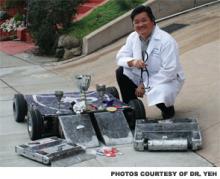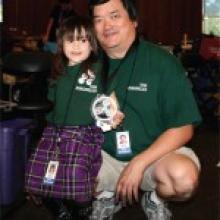User login
“The box is locked, the lights are on. It’s robot fighting time. Sewer Snake charges first. He’s lifting Ragin Scotsman high in the air. Ragin Scotsman manages to escape his death grip and slams Sewer Snake against the wall. Oh no! His front wheel just fell off!”
Jim Yeh, DO, has better things to do with his spare time than watch TV or play golf. For the past dozen years, he has been designing and building robots that fight other robots at events that attract techies nationwide.
It all started harmlessly, when he and his six-year-old son, Forrest, were watching a comedy sketch on TV featuring battling robots. When Forrest suggested they build robots together, Dr. Yeh reluctantly agreed.
Since then, he has enjoyed crushing his opponents. Destroying them, actually. He’s entered his robots in more than 20 events and has placed 10 times, winning ribbons, medals, and international recognition.
“We’d always heard of these secret robot fights that go on in local warehouses,” says Dr. Yeh, president at Alameda Inpatient Medical, a 10-hospitalist group in Alameda, Calif. “I’ve always been interested in building things you can destroy.”
Sounds a bit ironic for a physician who has dedicated his life to healing people. But when it comes to nuts, bolts, and titanium, let the fights begin.
Big, Bad, and Bold
Over the past decade, Dr. Yeh has designed and built five robots in his garage, learning his newfound trade from books, other builders, and more recently, the Internet. His first robot took six months to build, he says. Named Robo Master by his son, it had a titanium shell, four-wheel drive, and was strong enough to lift 300 pounds.
Unfortunately, Robo Master made the ultimate sacrifice. During its very first fight, it was slammed against a wall. Its death was premature but quick. It did not suffer. Its body parts were later donated to science—actually, to other robots built by Dr. Yeh.
Several of Dr. Yeh’s robots are still very much alive, however.
At 30 pounds, “The Bully” is considered a featherweight and ranked second in its weight class in the world by BotRank.com. With help from his dad, Forrest drives the robot during events, controlling it remotely.
To encourage his wife, Buffy, to join in the family fun, Dr. Yeh built a 60-pound robot for her in 2004; named “Come To Mama,” the robot is now ranked 22nd in the world in its weight class. It features a drum that spins about 2,000 RPMs and has placed first, second, and third in various competitions.
“She tried driving it but didn’t like it,” says Dr. Yeh, explaining that a robot’s performance in the ring is based 10% on robot, 90% on driver. “But how else was I going to convince my wife to let me build a big toy?”
Building such toys isn’t exactly cheap. While Dr. Yeh says the price of each of his robots was in the four-figure range, he knows other builders who equate their cost to a college education.
Dr. Yeh’s latest prodigy is called “Ragin Scotsman.” At 220 pounds, this heavyweight stands about 10 inches tall and is roughly 2.5 square feet. When his son was a member of his high school’s robotics club, he grew tired of the featherweight division and wanted to fight a bigger robot.
Ragin Scotsman is, indeed, bigger and badder. Built in 2011, its superpowers would intimidate Ironman. According to Dr. Yeh, it has the “acceleration of a race car and the aggressiveness of a bulldog.” It can get under its opponents and forcibly throw them against the wall. Not to mention its flame thrower, which can melt their electronics.
At one 2012 event, the Science Channel was filming fights for a new show called “Killer Robots.” Initially, Ragin Scotsman wasn’t one of the stars; however, after the producer watched its aggressiveness and, of course, its flame-throwing ability, Ragin Scotsman was filmed fighting other robots.
Despite its toughness, Dr. Yeh says this robot rarely beats top-ranked rivals, “Sewer Snake” and “Original Sin.”
“These robots are very talented,” he says, adding that they have fought over 100 times. “Ragin Scotsman probably has 40 fights under its belt. Every time we fight, we will win one out of four fights against them.”
He says drivers must learn to anticipate the other drivers’ moves, which takes practice. Some of his friends analyze each fight, studying driver habits so they can predict maneuvers. For example, after every hit, one driver may always signal his robot to turn left.
For the most part, he believes good drivers are able to “negotiate that sweet [vulnerable] spot” before destroying the other robot. He refers to some robots as one-hit wonders. After performing the single task they were designed to do, they have nothing new to offer and end up losing.
Break ‘Em, Build ‘Em
Win or lose, what attracts Dr. Yeh to the hobby is the engineering, building, and camaraderie. He says the robotics community is one big, happy family. Even if his robot gets destroyed, friends will help him rebuild it so it can later fight other robots, including their own.
There may be one more robot in Dr. Yeh’s future. Although he hasn’t made any commitments, he envisions that it would involve pneumatics, using pressurized gas to lift or flip challenging robots on their heads or vault them against walls.
Until then, Dr. Yeh keeps asking himself one question—how can he use his mechanical, engineering, and electrical talent in medicine?
“I’m still trying to figure out if there’s a connection between the two,” he says. “Where’s the bridge?”
Regardless of the outcome, he’ll continue enjoying this hobby. Unlike his day job, he says this is one activity where no one demands anything from him.
Carol Patton is a freelance writer in Las Vegas.
“The box is locked, the lights are on. It’s robot fighting time. Sewer Snake charges first. He’s lifting Ragin Scotsman high in the air. Ragin Scotsman manages to escape his death grip and slams Sewer Snake against the wall. Oh no! His front wheel just fell off!”
Jim Yeh, DO, has better things to do with his spare time than watch TV or play golf. For the past dozen years, he has been designing and building robots that fight other robots at events that attract techies nationwide.
It all started harmlessly, when he and his six-year-old son, Forrest, were watching a comedy sketch on TV featuring battling robots. When Forrest suggested they build robots together, Dr. Yeh reluctantly agreed.
Since then, he has enjoyed crushing his opponents. Destroying them, actually. He’s entered his robots in more than 20 events and has placed 10 times, winning ribbons, medals, and international recognition.
“We’d always heard of these secret robot fights that go on in local warehouses,” says Dr. Yeh, president at Alameda Inpatient Medical, a 10-hospitalist group in Alameda, Calif. “I’ve always been interested in building things you can destroy.”
Sounds a bit ironic for a physician who has dedicated his life to healing people. But when it comes to nuts, bolts, and titanium, let the fights begin.
Big, Bad, and Bold
Over the past decade, Dr. Yeh has designed and built five robots in his garage, learning his newfound trade from books, other builders, and more recently, the Internet. His first robot took six months to build, he says. Named Robo Master by his son, it had a titanium shell, four-wheel drive, and was strong enough to lift 300 pounds.
Unfortunately, Robo Master made the ultimate sacrifice. During its very first fight, it was slammed against a wall. Its death was premature but quick. It did not suffer. Its body parts were later donated to science—actually, to other robots built by Dr. Yeh.
Several of Dr. Yeh’s robots are still very much alive, however.
At 30 pounds, “The Bully” is considered a featherweight and ranked second in its weight class in the world by BotRank.com. With help from his dad, Forrest drives the robot during events, controlling it remotely.
To encourage his wife, Buffy, to join in the family fun, Dr. Yeh built a 60-pound robot for her in 2004; named “Come To Mama,” the robot is now ranked 22nd in the world in its weight class. It features a drum that spins about 2,000 RPMs and has placed first, second, and third in various competitions.
“She tried driving it but didn’t like it,” says Dr. Yeh, explaining that a robot’s performance in the ring is based 10% on robot, 90% on driver. “But how else was I going to convince my wife to let me build a big toy?”
Building such toys isn’t exactly cheap. While Dr. Yeh says the price of each of his robots was in the four-figure range, he knows other builders who equate their cost to a college education.
Dr. Yeh’s latest prodigy is called “Ragin Scotsman.” At 220 pounds, this heavyweight stands about 10 inches tall and is roughly 2.5 square feet. When his son was a member of his high school’s robotics club, he grew tired of the featherweight division and wanted to fight a bigger robot.
Ragin Scotsman is, indeed, bigger and badder. Built in 2011, its superpowers would intimidate Ironman. According to Dr. Yeh, it has the “acceleration of a race car and the aggressiveness of a bulldog.” It can get under its opponents and forcibly throw them against the wall. Not to mention its flame thrower, which can melt their electronics.
At one 2012 event, the Science Channel was filming fights for a new show called “Killer Robots.” Initially, Ragin Scotsman wasn’t one of the stars; however, after the producer watched its aggressiveness and, of course, its flame-throwing ability, Ragin Scotsman was filmed fighting other robots.
Despite its toughness, Dr. Yeh says this robot rarely beats top-ranked rivals, “Sewer Snake” and “Original Sin.”
“These robots are very talented,” he says, adding that they have fought over 100 times. “Ragin Scotsman probably has 40 fights under its belt. Every time we fight, we will win one out of four fights against them.”
He says drivers must learn to anticipate the other drivers’ moves, which takes practice. Some of his friends analyze each fight, studying driver habits so they can predict maneuvers. For example, after every hit, one driver may always signal his robot to turn left.
For the most part, he believes good drivers are able to “negotiate that sweet [vulnerable] spot” before destroying the other robot. He refers to some robots as one-hit wonders. After performing the single task they were designed to do, they have nothing new to offer and end up losing.
Break ‘Em, Build ‘Em
Win or lose, what attracts Dr. Yeh to the hobby is the engineering, building, and camaraderie. He says the robotics community is one big, happy family. Even if his robot gets destroyed, friends will help him rebuild it so it can later fight other robots, including their own.
There may be one more robot in Dr. Yeh’s future. Although he hasn’t made any commitments, he envisions that it would involve pneumatics, using pressurized gas to lift or flip challenging robots on their heads or vault them against walls.
Until then, Dr. Yeh keeps asking himself one question—how can he use his mechanical, engineering, and electrical talent in medicine?
“I’m still trying to figure out if there’s a connection between the two,” he says. “Where’s the bridge?”
Regardless of the outcome, he’ll continue enjoying this hobby. Unlike his day job, he says this is one activity where no one demands anything from him.
Carol Patton is a freelance writer in Las Vegas.
“The box is locked, the lights are on. It’s robot fighting time. Sewer Snake charges first. He’s lifting Ragin Scotsman high in the air. Ragin Scotsman manages to escape his death grip and slams Sewer Snake against the wall. Oh no! His front wheel just fell off!”
Jim Yeh, DO, has better things to do with his spare time than watch TV or play golf. For the past dozen years, he has been designing and building robots that fight other robots at events that attract techies nationwide.
It all started harmlessly, when he and his six-year-old son, Forrest, were watching a comedy sketch on TV featuring battling robots. When Forrest suggested they build robots together, Dr. Yeh reluctantly agreed.
Since then, he has enjoyed crushing his opponents. Destroying them, actually. He’s entered his robots in more than 20 events and has placed 10 times, winning ribbons, medals, and international recognition.
“We’d always heard of these secret robot fights that go on in local warehouses,” says Dr. Yeh, president at Alameda Inpatient Medical, a 10-hospitalist group in Alameda, Calif. “I’ve always been interested in building things you can destroy.”
Sounds a bit ironic for a physician who has dedicated his life to healing people. But when it comes to nuts, bolts, and titanium, let the fights begin.
Big, Bad, and Bold
Over the past decade, Dr. Yeh has designed and built five robots in his garage, learning his newfound trade from books, other builders, and more recently, the Internet. His first robot took six months to build, he says. Named Robo Master by his son, it had a titanium shell, four-wheel drive, and was strong enough to lift 300 pounds.
Unfortunately, Robo Master made the ultimate sacrifice. During its very first fight, it was slammed against a wall. Its death was premature but quick. It did not suffer. Its body parts were later donated to science—actually, to other robots built by Dr. Yeh.
Several of Dr. Yeh’s robots are still very much alive, however.
At 30 pounds, “The Bully” is considered a featherweight and ranked second in its weight class in the world by BotRank.com. With help from his dad, Forrest drives the robot during events, controlling it remotely.
To encourage his wife, Buffy, to join in the family fun, Dr. Yeh built a 60-pound robot for her in 2004; named “Come To Mama,” the robot is now ranked 22nd in the world in its weight class. It features a drum that spins about 2,000 RPMs and has placed first, second, and third in various competitions.
“She tried driving it but didn’t like it,” says Dr. Yeh, explaining that a robot’s performance in the ring is based 10% on robot, 90% on driver. “But how else was I going to convince my wife to let me build a big toy?”
Building such toys isn’t exactly cheap. While Dr. Yeh says the price of each of his robots was in the four-figure range, he knows other builders who equate their cost to a college education.
Dr. Yeh’s latest prodigy is called “Ragin Scotsman.” At 220 pounds, this heavyweight stands about 10 inches tall and is roughly 2.5 square feet. When his son was a member of his high school’s robotics club, he grew tired of the featherweight division and wanted to fight a bigger robot.
Ragin Scotsman is, indeed, bigger and badder. Built in 2011, its superpowers would intimidate Ironman. According to Dr. Yeh, it has the “acceleration of a race car and the aggressiveness of a bulldog.” It can get under its opponents and forcibly throw them against the wall. Not to mention its flame thrower, which can melt their electronics.
At one 2012 event, the Science Channel was filming fights for a new show called “Killer Robots.” Initially, Ragin Scotsman wasn’t one of the stars; however, after the producer watched its aggressiveness and, of course, its flame-throwing ability, Ragin Scotsman was filmed fighting other robots.
Despite its toughness, Dr. Yeh says this robot rarely beats top-ranked rivals, “Sewer Snake” and “Original Sin.”
“These robots are very talented,” he says, adding that they have fought over 100 times. “Ragin Scotsman probably has 40 fights under its belt. Every time we fight, we will win one out of four fights against them.”
He says drivers must learn to anticipate the other drivers’ moves, which takes practice. Some of his friends analyze each fight, studying driver habits so they can predict maneuvers. For example, after every hit, one driver may always signal his robot to turn left.
For the most part, he believes good drivers are able to “negotiate that sweet [vulnerable] spot” before destroying the other robot. He refers to some robots as one-hit wonders. After performing the single task they were designed to do, they have nothing new to offer and end up losing.
Break ‘Em, Build ‘Em
Win or lose, what attracts Dr. Yeh to the hobby is the engineering, building, and camaraderie. He says the robotics community is one big, happy family. Even if his robot gets destroyed, friends will help him rebuild it so it can later fight other robots, including their own.
There may be one more robot in Dr. Yeh’s future. Although he hasn’t made any commitments, he envisions that it would involve pneumatics, using pressurized gas to lift or flip challenging robots on their heads or vault them against walls.
Until then, Dr. Yeh keeps asking himself one question—how can he use his mechanical, engineering, and electrical talent in medicine?
“I’m still trying to figure out if there’s a connection between the two,” he says. “Where’s the bridge?”
Regardless of the outcome, he’ll continue enjoying this hobby. Unlike his day job, he says this is one activity where no one demands anything from him.
Carol Patton is a freelance writer in Las Vegas.


